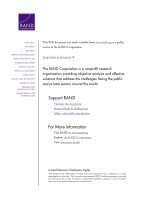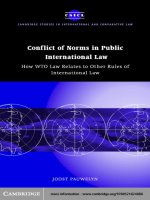THE ‘WAR ON TERROR’ AND THE FRAMEWORK OF INTERNATIONAL LAW doc
Bạn đang xem bản rút gọn của tài liệu. Xem và tải ngay bản đầy đủ của tài liệu tại đây (4.35 MB, 542 trang )
This page intentionally left blankThis page intentionally left blankThis page intentionally left blankThis page intentionally left blank
This page intentionally left blank
THE ‘WAR ON TERROR’ AND THE
FRAMEWORK OF INTERNATIONAL LAW
The acts of lawlessness committed on September 11, 2001 were swiftly
followed by a ‘war on terror’. This book sets out the essential features
of the international legal framework against which the 9/11 attacks and
the lawfulness of measures taken in response thereto fall to be assessed.
It addresses, in an accessible manner, the relevant law in relation to:
‘terrorism’, questions as to ‘responsibility’ for it, the criminal law frame-
work, lawfulconstraints on the use of force, the humanitarian law that
governs in armed conflict, and international human rights law. It indicates
the existence of a legal framework capable of addressing events such as
9/11 and governing responses thereto. It raises questions as to the com-
patibility of the ‘war on terror’ with this legal framework, and questions
the implications for states responsible for violations, for third states and
for the international rule of law.
helen duffy is the Legal Director of INTERIGHTS, an international
human rights law centre.Shepreviously workedasLegalOfficerinthePros-
ecutor’s Office, International Criminal Tribunal for the Former Yugoslavia
(ICTY) in The Hague, as Counsel to Human Rights Watch, New York,
and as Legal Director of the Centre for Human Rights and Legal Action,
Guatemala. She specialises in human rights and international criminal law.
She currently lives in The Hague.
THE ‘WAR ON TERROR’
AND THE FRAMEWORK OF
INTERNATIONAL LAW
HELEN DUFFY
cambridge university press
Cambridge, New York, Melbourne, Madrid, Cape Town, Singapore, São Paulo
Cambridge University Press
The Edinburgh Building, Cambridge cb2 2ru,UK
First published in print format
isbn-13 978-0-521-83850-4
isbn-13 978-0-521-54735-2
isbn-13 978-0-511-12895-0
© Helen Duffy 2005
2005
Informationonthistitle:www.cambrid
g
e.or
g
/9780521838504
This publication is in copyright. Subject to statutory exception and to the provision of
relevant collective licensing agreements, no reproduction of any part may take place
without the written permission of Cambridge University Press.
isbn-10 0-511-12895-9
isbn-10 0-521-83850-9
isbn-10 0-521-54735-0
Cambridge University Press has no responsibility for the persistence or accuracy of urls
for external or third-party internet websites referred to in this publication, and does not
guarantee that any content on such websites is, or will remain, accurate or appropriate.
Published in the United States of America by Cambridge University Press, New York
www.cambridge.org
hardback
p
a
p
erback
p
a
p
erback
eBook (EBL)
eBook (EBL)
hardback
Formymother Rosemary, partner Fabricio and
son Luca
CONTENTS
Preface and acknowledgements page xiii
Ta ble of abbreviations xv
Ta b l e o f cases xx
Ta ble of conventions xxxii
1Introduction 1
1.1 Preliminary remarks 1
1.2 Some legal basics 4
1.2.1 Sources of international law 4
1.2.2 How international law changes 7
1.2.3 The legal framework as an interconnected whole 9
1.3 Structure of the book 10
1.4 Overview of chapters 10
part one
2‘Te rrorism’ in international law 17
2.1 Developments towards a comprehensive definition of
international terrorism 18
2.1.1 Pre-September 11: historical developments 18
2.1.2 Post September 11: a global convention? 20
2.1.3 Specific international conventions 23
2.1.4 Terrorism in armed conflict 25
2.1.5 Regional conventions 26
2.1.6 National measures 30
2.2 Do we know it when we see it? Defining terrorism and
customary law 31
2.2.1 Identifying elements of a definition of terrorism from
international instruments 32
2.2.2 Other international practice: General Assembly, Security
Council and criminal tribunals 37
vii
viii contents
2.2.3 Meeting the legality threshold: preliminary conclusions on
customary international law? 40
2.3 Filling the gap? Terrorism and other international legal norms 41
2.4 Conclusion 44
3International responsibility and terrorism 47
3.1 State responsibility in international law 48
3.1.1 Responsibility of a state for acts of terrorism 48
3.1.2 Responsibility for breach of obligations in the fight
against terrorism 55
3.1.3 Consequences of international responsibility for acts of
terrorism or for breach of obligations relating to the fight
against terrorism 58
3.2 Responsibility of non-state actors in international law 61
3.2.1 Criminal law 62
3.2.2 International humanitarian law 63
3.2.3 Human rights law? 64
3.3 Conclusion 69
part two
4Criminal justice 73
4A THE LEGAL FRAMEWORK 73
4A.1 Crimes, principles of criminal law and jurisdiction 76
4A.1.1 Crimes under international and national law 76
4A.1.2 Relevant principles of criminal law 93
4A.1.3 Jurisdiction to prosecute 99
4A.2 Implementing justice: international cooperation
and enforcement 106
4A.2.1 Extradition 107
4A.2.2 Mutual assistance 114
4A.2.3 Cooperation and the Security Council 116
4B CRIMINAL JUSTICE IN PRACTICE
POST SEPTEMBER 11 117
4B.1 Prosecutions in practice post 9/11 119
4B.1.1 Paucity of prosecutions 119
4B.1.2 International v. national models of justice post 9/11 124
4B.2 Developments in law and practice on cooperation 131
4B.2.1 International standards and procedures 131
4B.2.2 Streamlining the extradition process? Developments
in extradition procedure 134
4B.2.3 Inter-state cooperation in practice post 9/11 138
4B.3 Conclusion 142
contents ix
5Peaceful resolution of disputes and use of force 144
5A THE LEGAL FRAMEWORK 144
5A.1 The obligation to resolve international disputes by
peaceful means 144
5A.2 The use of force in international law: general rule and
exceptions 146
5A.2.1 Self defence 149
5A.2.2 Security Council: maintenance of international
peace and security 168
5A.3 Other justifications for the use of force? 178
5A.3.1 Humanitarian intervention 179
5A.3.2 Pro-democratic intervention 183
5A.3.3 Self help: breakdown in international
enforcement? 184
5B THE USE OF FORCE POST SEPTEMBER 11 186
5B.1 Afghanistan 186
5B.1.1 Key questions arising 188
5B.2 Iraq 197
5B.2.1 Key questions arising 199
5B.3 United States National Security Strategy 209
5B.3.1 Expanding self defence? 209
5B.3.2 Internationalism, unilateralism
or exceptionalism? 211
5B.4 Conclusion 212
part three
6International humanitarian law 217
6A THE LEGAL FRAMEWORK 217
6A.1 When and where IHL applies 218
6A.1.1 Armed conflict: international
or non-international 218
6A.1.2 Temporal scope of IHL 222
6A.1.3 Territorial scope of IHL 223
6A.2 Applicable law 223
6A.3 Specific aspects of IHL 228
6A.3.1 Targeting: the principle of distinction
and proportionality 228
6A.3.2 Methods and means of warfare: unnecessary
suffering 236
6A.3.3 Humanitarian protections 239
6A.3.4 Occupiers’ obligations 244
x contents
6A.3.5 Responsibility and ensuring compliance
under IHL 245
6B INTERNATIONAL HUMANITARIAN LAW AND THE
‘WAR ON TERROR’ 249
6B.1 Armed conflicts since 9/11 250
6B.1.1 Armed conflict and ‘terrorist groups of global
reach’ 250
6B.1.2 The Afghan conflict, its nature, beginning and
end 255
6B.1.3 The conflict in Iraq and obligations of occupying
forces 258
6B.2 The Afghan conflict and particular issues of IHL
compliance 259
6B.2.1 Targeting 259
6B.2.2 Methods and means: cluster bombs in
Afghanistan 264
6B.2.3 Humanitarian protection of prisoners: executions,
torture and inhumane treatment 266
6B.2.4 Transparency, inquiry and onus of proof ? 270
6B.3 Conclusion 271
7International human rights law 274
7A THE LEGAL FRAMEWORK 274
7A.1 Sources and mechanisms of international human rights law 275
7A.2 Scope of application of human rights obligations 282
7A.2.1 Territorial scope of human rights obligations – ‘the
jurisdiction question’ 282
7A.2.2 Personal scope of human rights obligations: irrelevance
of nationality 289
7A.3 Human rights in crisis or emergency: accommodating security
imperatives 290
7A.3.1 Lawful limitations: treaty ‘claw back’ clauses 291
7A.3.2 Temporary suspension: derogation clauses 292
7A.3.3 Customary law and emergency 297
7A.3.4 Harmony in conflict? The relationship between IHL
and human rights law 298
7A.4 Human rights obligations and terrorism 301
7A.4.1 Protecting human security: positive human rights
obligations 301
7A.4.2 State responsibility and human rights violations 305
7A.4.3 Specific rights protected and counter-terrorism 307
7A.5 Conclusion 331
contents xi
7B HUMAN RIGHTS AND SECURITY
POST SEPTEMBER 11 332
7B.1 Executing the ‘war on terror’ extra-territorially 332
7B.1.1 Arrest and detention of prisoners abroad? 333
7B.1.2 Aerial bombardment in Afghanistan or Iraq? 334
7B.1.3 Targeted killings? 336
7B.1.4 Clarifying and enforcing extra-territorial human
rights law? 337
7B.2 The ‘war’ and human rights 339
7B.2.1 The Yemen attack: armed conflict
or assassination? 340
7B.3 Derogation and emergency post 9/11 344
7B.3.1 An emergency threatening the life of the nation? 345
7B.3.2 A valid process of derogation? 346
7B.3.3 Linkage between measures taken and
the emergency? 347
7B.4 ‘Terrorism’ and the legality principle 348
7B.4.1 Terrorism, criminal responsibility and nullum
crimen sine lege 350
7B.4.2 Terrorism, penalties and nulla poena sine lege 352
7B.5 Torture and inhuman treatment: Abu Ghraib and beyond 353
7B.6 Indefinite detention 355
7B.7 Asylum and refugee exclusion 357
7B.8 Cooperation in criminal matters and human rights
post 9/11 358
7B.9 ‘Proscribing dissent’ – expression, association, assembly 364
7B.10 Profiling, protecting and anti-discrimination 366
7B.11 The role of the judiciary as guardian of human rights
post 9/11? 368
7B.11.1 ‘Listing’ proscribed organisations 368
7B.11.2 International ‘cooperation’: undermining the
judicial function 370
7B.11.3 Independence and impartiality impaired: ‘special’
courts 370
7B.12 Accountability 371
7B.13 Conclusion 373
8 Case study –Guantanamo Bay detentions under international
human rights and humanitarian law 379
8A GUANTANAMO BAY AND ITS DETAINEES: THE BASIC
FACTS 380
8A.1.1 Treatment of detainees in Guantanamo Bay 382
8A.1.2 Seeking justice in US and other courts 385
xii contents
8A.1.3 Overview of military procedures governing
detention 387
8A.1.4 Trial by military commission 388
8B APPLICATION OF HUMANITARIAN AND HUMAN
RIGHTS LAW TO DETAINEES IN GUANTANAMO
BAY 390
8B.2.1 The framework: international humanitarian law 391
8B.2.2 The framework: international human rights law 392
8B.3 Categories of detainees 396
8B.3.1 Entitlement to POW status 398
8B.3.2 ‘Civilian’ detainees 401
8B.3.3 Persons not covered by GC III or GC IV? 403
8B.4 Specific rights of detainees under IHL and IHRL 404
8B.4.1 Existence of a lawful basis for detention 404
8B.4.2 Status determinations 407
8B.4.3 Information on reasons for arrest and
detention 411
8B.4.4 Judicial oversight of detention 413
8B.4.5 Prosecution – fair trial rights 417
8B.5 Standards of protection compared: implications
of POW status? 428
8B.5.1 Rights regarding interrogation 428
8B.5.2 Indefinite detention – repatriation 429
8C RESPONDING TO GUANTANAMO 430
8C.6 The obligations of third states 430
8C.7 The international response to the Guantanamo
detentions 434
8C.8 Guantanamo Bay: implications and potential
repercussions? 437
8C.9 Conclusion 441
9Conclusion 443
9.1 September 11 as opportunity and the ‘war on terror’
response 443
9.2 The legal framework 445
9.3 The ‘war on terror’ and international legality: some essential
characteristics 447
9.4 Early reactions and key challenges: is the pendulum swinging and
where might it stop? 449
Bibliography 453
Index 465
PREFACE AND ACKNOWLEDGEMENTS
This book grew from a paper I wrote for INTERIGHTS shortly after the
September 11 attacks. The paper was motivated by the apparent marginal-
isation of the issue of legality in public discourse on responses to those
attacks, and the surprising dearth of legal material published in their
immediate aftermath. In the void where there should have been debate
on which responses would serve the interests of international justice,
peace, security and the rule of law, the confusion and need for clarifica-
tion of legal issues grew. I was encouraged by those who used that paper
in their work, including partner organisations in the many countries in
which INTERIGHTS works, to publish an expanded piece that addresses
additional aspects of the legal framework and considers it alongside the
practice of the ‘war on terror’ since 11 September 2001.
Since then, international lawyers have become more vocal and there is
certainly more published material. International law is no longer absent
from political discourse on the ‘war on terror’, and indeed there may be
anewfoundalertness to issues of international legality in public debate
that is in many respects promising. However at times it seems that there
is greater confusion than ever, and with it an increased vulnerability in
the international legal order. This book hopes to contribute to addressing
the confusion, and the perception of legal vacuum. It is written from the
perspective of a practitioner in the field of human rights andinternational
criminal law, where international law, its legitimacy and standing, are
essential tools not only to combat terrorism but to guard against future
human rights abuse in other contexts.
Many people havecontributed to thisbook, by providing ideas,research
and editing assistanceand experienceof the‘war on terror’ as alivedreality.
Iamgrateful to all INTERIGHTS staff, past and present and to its board.
Among the volunteers and associates who provided helpful research
and assistance along the way are Sanchita Hosali, Debbie Sayers, Mark
Pallis, Benedetta Lacey and Larissa Leiser. Particular thanks are due
to Silvia Borelli for excellent research assistance in the critical months
xiii
xiv preface and acknowledgements
leading up to publication, and to Moni Shrestha for her spirit and her edit-
ing and production assistance. Emma Playfair lent her careful editor’s eye
at various stages. I would like to thank Finola O’Sullivan, Jane O’Regan,
SueDickinson and Mary Leighton of Cambridge University Press for
the diligent work on the book, and especially Finola for her support
from the outset. Numerous friends and colleagues gave their time gen-
erously to reviewing, encouraging, cautioning and/or correcting, includ-
ing Jeremy McBride, Federico Andreu, Jelena Pejic, Kim Prost, Elizabeth
Wilmshurst, Gerry Simpson, Christine Chinkin, Claire Harris, Amelia
Nice,Xavier Aguirre, Hakan Friman, Osvaldo Guariglia and Fabricio
Guariglia. Immeasurable gratitude is due to Fabricio for his generous
approach to partnership and unwavering belief in the project, and to
Luca for giving so easily of the maternity leave that was by rights his, and
for inspiring hope.
ABBREVIATIONS
ACHR/American Convention on American Convention on Human
Human Rights Rights, San Jose, 22 November
1969, OAS Treaty Series, No. 36,
entered into force 18 July 1978
AI Amnesty International
AJIL American Journal of International
Law
AP I/First Additional Protocol to Protocol Additional to the Geneva
the Geneva Conventions Conventions of 12August 1949, and
relating to the Protection of Victims
of International Armed Conflicts,
8June1977,1125 UNTS 3, entered
into force 7 December 1978
AP II/Second Additional Protocol Protocol Additional to the Geneva
to the Geneva Conventions Conventions of 12August 1949, and
Relating to the Protection of
Victims of Non-International
Armed Conflicts, 8 June 1977, 1125
UNTS 609, entered into force 7
December 1978
BYIL British Yearbook of International
Law
CCPR Covenant on Civil and Political
Rights
DR Council of Europe, Decisions and
reports of the European Commission
on Human Rights
ECHR/European Convention on European Convention for the
Human Rights Protection of Human Rights and
Fundamental Freedoms, Rome,
xv
xvi table ofabbreviations
4November1950, ETS No. 5,
entered into force 3 September 1953
ECtHR European Court of Human Rights
EHRR European Human Rights Reports
EJIL European Journal of International
Law
ETS European Treaty Series
GA Res. General Assembly Resolution
GC I/First Geneva Convention Geneva Convention for the
Amelioration of the Condition of
the Wounded andSickinArmed
Forces in the Field, 12 August 1949,
75 UNTS 31, entered into force 21
October 1950
GC II /Second Geneva Geneva Convention for the
Convention Amelioration of the Condition of
Wounded, Sick and Shipwrecked
Members ofArmedForces at Sea,
12 August 1949, 75 UNTS 85,
entered into force 21 October
1950
GC III/Third Geneva Geneva Convention Relative to the
Convention Treatment o f Prisoners of War, 12
August 1949, 75 UNTS 135, entered
into force 21 October 1950
GC IV/Fourth Geneva Geneva Convention Relative to the
Convention Protection of Civilian Persons in
Time of War, 12 August 1949, 75
UNTS 287, entered into force 21
October 1950
HLJ Harvard Law Journal
HRQ Human Rights Quarterly
IACtHR Inter-American Court of Human
Rights
ICC International Criminal Court
ICC Statute Statute of the International
Criminal Court, Rome, 17 July
1998, UN Doc. A/CONF.183/9,
entered into force 1 July 2002
table of abbreviations xvii
ICCPR/International Covenant International Covenant on Civil and
on Civil and Political Rights Political Rights, New York, 16
December 1966, 999 UNTS 171,
entered into force 23 March 1976
ICESCR/International Covenant International Covenant on
on Economic, Social and Economic, Social and Cultural
Cultural Rights Rights, New York, 16 December
1966, 993 UNTS 3, entered into
force 3 January 1976
ICJ International Court of Justice
ICJ Reports Reports of the International Court of
Justice
ICLQ International and Comparative Law
Quarterly
ICRC International Committee of the Red
Cross
ICRC Commentary to AP I J. Pictet et al.(eds.), Commentary on
the Additional Protocols of 8 June
1977 to the Geneva Conventions of
12 August 1949, Section I: Protocol
Additional to the Geneva
Conventions of 12 August 1949, and
relating to the Protection of Victims
of International Armed Conflicts
(Protocol I) (ICRC, Geneva, 1987)
ICRC Commentary to AP II J. Pictet et al. (eds.), Commentary on
the Additional Protocols of 8 June
1977 to the Geneva Conventions of
12 August 1949, Section II: Protocol
Additional to the Geneva
Conventions of 12 August 1949, and
relating to the Protection of Victims of
Non-International Armed Conflicts
(Protocol II) (ICRC, Geneva, 1987)
ICRC Commentary to GC I J. Pictet (ed.), Geneva Convention
for the Amelioration of the Condition
of the Wounded and Sick in Armed
Forces in the Field: Commentary
(ICRC, Geneva, 1952)
xviii table ofabbreviations
ICRC Commentary to GC II J. Pictet (ed.), Geneva Convention
for the Amelioration of the Condition
of Wounded, Sick and Shipwrecked
Members of Armed Forces at Sea:
Commentary (ICRC, Geneva, 1960)
ICRC Commentary to GC III J. de Preux (ed.), Geneva
Convention relative to the Treatment
of Prisoners of War: Commentary
(ICRC, Geneva, 1960)
ICRC Commentary to GC IV O. Uhler and H. Coursier (eds.),
Geneva Convention relative to the
Protection of Civilian Persons in
Time of War: Commentary (ICRC,
Geneva, 1950)
ICTR International Criminal Tribunal for
Rwanda
ICTR Statute Statute of the International
Criminal Tribunal for Rwanda,
annexed to SC Res. 955 (1994),
8November1994
ICTY International Criminal Tribunal for
the Former Yugoslavia
ICTY Statute Statute of the International
Criminal Tribunal for the Former
Yugoslavia, annexed to SC Res. 827
(1993), 23 May 1993
IHL International humanitarian law
IHRL International human rights law
ILC International Law Commission
ILC Commentaries on Articles International Law Commission,
on State Responsibility Commentaries on Articles on
Responsibility of States for
Internationally Wrongful Acts,
Report of the ILC on the work of its
53rd session,UNDoc.A/56/10
(2001), Chapter IV, pp. 59–365
ILC Yearbook Ye arbook of the International Law
Commission
table of abbreviations xix
ILC’s Articles on State International Law Commission,
Responsibility Articles on Responsibility of States
for Internationally Wrongful Acts,
Report of the ILC on the work of its
53rd session,UNDoc.A/56/10
(2001), Chapter IV, pp. 43–59
ILM International Legal Materials
ILR International Law Reports
IRRC International Review of the Red Cross
LJIL Leiden Journal of International Law
NYIL Netherlands Yearbook of
International Law
OAS Organisation of American States
OAU Organisation of African Unity
OJ Official Journal of the European
Communities
Oppenheim’s International Law R.Y. Jennings and A. Watts (eds.),
Oppenheim’s International Law, 9th
ed. (London, 1992), vol. I
PCIJ Permanent Court of International
Justice
RdC Recueil des cours de l’Acad´emie de
droit international de L’Haye
Reports European Court of Human Rights,
Reports of judgments and decisions
SAARC South Asian Association for
Regional Cooperation
SC Res. Security Council Resolution
UDHR/Universal Declaration Universal Declaration on Human
on Human Rights Rights, GA Res. 217A (III),
10 December 1948
UN Charter Charter of the United Nations,
San Francisco, 26 June 1945,
entered into force 24 October 1945
UNTS United Nations Treaty Series
VCLT Vienna Convention on the Law of
Treaties between States and
International Organizations or
between International
Organizations
TABLE OF CASES
Abbasi and Another v. Secretary of State for Foreign and Commonwealth
Affairs, [2002] EWCA Civ. 1598 123, 282, 289, 379, 384, 385, 387, 396,
414, 417, 429, 434
Abella v. Argentina, Case 11.137, Report 55/97, Annual Report of the
IACtHR 1997 300, 301, 309
Aduayom et al. v. Togo, Comm. 422–24/1990 323
Agga v. Greece (No.2), Appl. 50776/99; 52912/99, ECtHR, 17 October
2002, unreported 331
Ahmed v. Austria, Appl. 25964/94, ECtHR, 17 December 1996, 24 (1997)
EHRR 278 326
Aksoy v. Tu rkey, Appl. 21987/93, ECtHR, 18 December 1996, Reports
1996-VI 293, 294, 296, 297, 314, 323, 413, 414
Al Odah v. United States, 321 F.3d 1134 (DC Cir. 2003) 385, 386,
390
Al Odah v. United States, No.02-5251 2002 12, 385
Alegria (Neira) et al. v. Peru (Merits), IACtHR, 19 January 1995, Series C,
21 261
Alejandre Jr (Armando) et al., Case 11.589, Inter-American Commission
on Human Rights, Report 86/99, 29 September 1999, Annual Report
1999 311
Allan v. United Kingdom, Appl. 48539/99, ECtHR, 5 November 2002,
Reports 2002-IX 420
Allenet de Ribemont v. France, Appl. 15175/89, ECtHR, 7 August 1996,
Series A, 308 318
Al-Nashif v. Bulgaria, Appl. 50963/99, ECtHR, 20 June 2002,
unreported 393
Amnesty International, Comit´eLoosli Bachelard, Lawyers Committee for
Human Rights, Association of Members of the Episcopal Conference of
East Africa, Comm. 48/90, 50/91, 52/91, 89/93, African Commission of
Human and People’s Rights, 13th Annual Activity Report 1999–2000
323
xx
table ofcases xxi
Asencios Lindo et al.,Case 11.182, Report 49/00, Annual Report of the
IACtHR 1999 304
Assenov v. Bulgaria, Appl. 24760/94, ECtHR, 28 October 1998, Reports
1998-VIII 302
Attorney-General of Israel v. Eichmann, Israel Supreme Court (1962),
36 ILR 277 78, 100, 101, 172
Austria v. Italy, Appl. 788/604, 11 January 1961, 4 Yearbook of European
Convention of Human Rights, 116 320
Ayas v. Sweden, Comm. 97/1997, CAT, Views of 12 November 1998, UN
Doc. CAT/C/21/D/97/1997 328
Aydin v. Turkey, Appl. 23178/94, ECtHR, 25 September 1997, 25 (1998)
EHRR 251 314
Aylor-Davis v. France,Appl. 22742/93, European Commission of Human
Rights, Admissibility Decision, 20 January 1994, DR 76-B, 164
329
B. and P. v. United Kingdom, Appl. 36337/97; 35974/97, ECtHR, 24 April
2001, Reports 2001-III 318
Bankovic v. Belgium and 16 other contracting states, Appl. 52207/99,
ECtHR, Admissibility Decision, 12 December 2001, Reports
2001-XII 232, 235, 284, 286, 300, 301, 306, 334, 335–6, 337, 339
Barcelona Traction, Light and Power Company Ltd, Second Phase, ICJ
Reports 1970, 3 9, 226, 306
Barrios Altos Case (Chumbipuma Aguirre et al. v. Peru)(Merits), 14 March
2001, IACtHR, Series C, 75 97, 303, 304
Blake v. Guatemala (Preliminary Objections),2July 1996, IACtHR, Series
C, 27 301
Brannigan and McBride v. United Kingdom, Appl. 1453/89; 1454/89,
26 May 1993, ECtHR, Series A, 258-B 297, 414, 424
Brogan v. United Kingdom, Appl. 11209/84, 29 November 1998, ECtHR,
Series A, 145 414
C.R. v. United Kingdom, Appl. 20190/92, 22 November 1995, ECtHR,
Series A, 335-C
Caroline case, 41 (1947) AJIL, 205 156, 157–8, 159, 162, 206, 209
Case concerning the Arrest Warrant of 11 April 2000 (Democratic Republic
of Congo v. Belgium), Judgment, 14 February 2002, ICJ Reports 2003,
3 98, 102
Castells v. Spain, Appl. 11798/85, 23 April 1992, ECtHR, Series A, 236
323
Castillo P´aez v. Peru (Merits), 3November 1997, IACtHR, Series C, 34
301
xxii table ofcases
Castillo Petruzzi and Others v. Peru (Merits),30May1999, IACtHR,
Series C, 52 314, 315, 350, 422
Celiberti de Casariego v. Uruguay, Comm. 56/1979, Human Rights
Committee, Views of 29 July 1981, UN Doc.
CCPR/C/13/D/56/1979 314
Certain Attributes of the Inter-American Commission on Human Rights
(Arts. 41, 42, 44, 46, 47, 50 and 51 of the American Convention on
Human Rights), Advisory Opinion OC-13/93, 16 July 1993, IACtHR,
Series A, 13 276
Certain Expenses of the United Nations (Article 17, paragraph 2 of the
Charter), Advisory Opinion, ICJ Reports 1962, 157 148, 177
Ceylan v. Tur ke y, Appl. 23556/94, 8 July 1999, ECtHR, Reports
1999-IV 324
Chahal v. United Kingdom, Appl. 22411/93, 15 November 1996, ECtHR,
Reports1996-V 114, 313, 326, 329, 414, 424
Ch´are Shalom ve Tsedek v. France, Appl. 27417/95, 27 June 2002, ECtHR,
Reports 2000-VII
Chumbipuma Aguirre. See Barrios Altos case
Cisse v. France, Appl. 51346/99, 9 April 2002, ECtHR, Reports
2002-III 324
Coard et al. v. The United States, Case 10.951, Inter-American
Commission on Human Rights, Report 109/99, 29 September 1999,
Annual Report (1999) 284, 285, 339
Corfu Channel (United Kingdom v. Albania), Merits, ICJ Reports 1949,
22 42, 44, 52, 180, 182, 185
Cox v. Canada, Comm. 539/1993, Human Rights Committee, Views of
9December 1994, UN Doc. CCPR/C/52/D/539/1993 328
Coyne v. United Kingdom, Appl. 25942/94, 24 September 1997, ECtHR,
Reports1997-V 317
Cyprus v. Turkey (Merits), Appl. 2578/94, 10 May 2001, ECtHR, Reports
2001-IV 284, 288, 306, 317
Cyprus v. Tur key, Commission Admissibility Decision, 26 May 1975, 2 DR
125 285, 286
Demirel v. Tur key, Appl. 39324/98, ECtHR, 28 January 2003,
unreported 317
Demjanuk, Re, 612 F.Supp. 544 9N. D Ohio 1985, affirmed 776 F2d 571
(6th Circ. 1985) 78, 100, 101
Djavit An v. Tur key,Appl. 20652/92, 20 February 2003, ECtHR, Reports
2003-III 286, 288
Decision of the Federal Supreme Court of Germany, 3 March 2004,
Strafverteitiger (BGH), StV 4/2004 119
table ofcases xxiii
Domukovsky, Tsiklauri, Gelbekniani and Dokvadze v. Georgia, Comm. 623,
624, 626 and 627/1995, Human Rights Committee, Views of 29 May
1998, UN Doc. CCPR/C/62/D/623/1995 426, 427
Doorson v. Netherlands, Appl. 20524/92, 26 March 1996, ECtHR, Reports
1996-II 418
Drodz and Janusek v. France and Spain, Appl. No. 12747/87, 26 June 1992,
ECtHR, Series A, 240 111, 285, 328, 362, 432
Dudgeon v. United Kingdom, Appl. 7525/76, 22 October 1981, ECtHR,
Series A, 45 287
Duinhof and Duijhof v. Netherlands, Appl. 9626/81; 9736/82, 4 May 1984,
ECtHR, Series A, 79 415
Einhorn v. France, Appl. 71555/01, Decision on admissibility, 16 October
2001, Reports 2001-XI 113, 315, 329, 432
Erdogdu v. Turke y, Appl. 25723/94, 15 June 2000, ECtHR, Reports
2000-VI 324
Ergi v. Turkey, Appl. 23818/94, ECtHR, 28 July 1998, 32 (2001) EHRR
388 310
Feidje v. Sweden, Appl. 12631/87, 29 October 1991, ECtHR, Series A,
212 318
Findlay v. United Kingdom, Appl/ 22107/93, 25 February 1997, ECtHR,
Reports 1997-I 317
Fox, Campbell and Hartley v. United Kingdom, Appl. 12244/86; 12245/86;
12383/86, 30 August 1990, ECtHR, Series A, 182
Gherebi v. Bush, No.03-55785, 2003 WL 22971053 386
G´omez Casafranca v. Peru, Comm. 981/2001, Human Rights Committee,
Views of 19 September 2003, UN Doc. CCPR/C/78/D/981/2001 321
G´omez V´asquez v. Spain, Comm. 701/1996, Human Rights Committee,
Views of 11 August 2000, UN Doc. CCPR/C/69/D/1996 426
Gonz´alez del Rio (Miguel) v. Peru, Comm. 263/1987, Human Rights
Committee, 28 October 1992, UN Doc. CCPR/C/46/263/1987
Greek case(Denmark, Norway, Sweden and Netherlands v. Greece), Appl.
Nos. 3321/67; 3322/67; 3323/67; 3344/67; European Commission of
Human Rights, Report, 18 November 1969, 12 (1969) Yearbook of
European Convention on Human Rights 1 293
Gundem (Ozgur) v. Tur ke y, Appl. 23144/93, 16 March 2000, ECtHR,
Reports 2000-III 323
Habeas Corpus in Emergency Situations (Arts. 27(2) and 7(6) of the
American Convention on Human Rights), Advisory Opinion OC-8/87,
30 January 1987, IACtHR, Series A, 8 151, 316
Haitian Centers Council, Inc. v. McNary, 969 F 2d 1326 (2nd Circuit 1992),
1342 381









